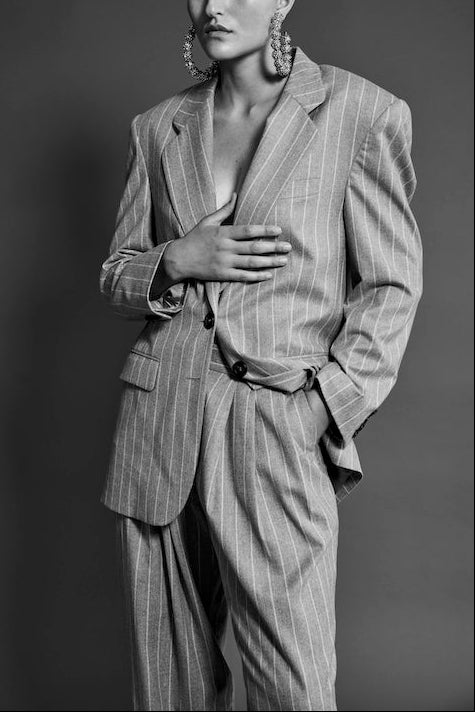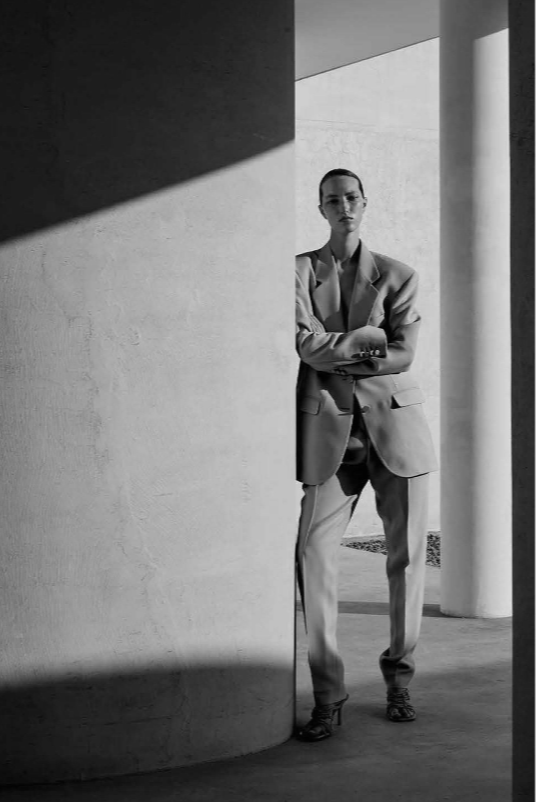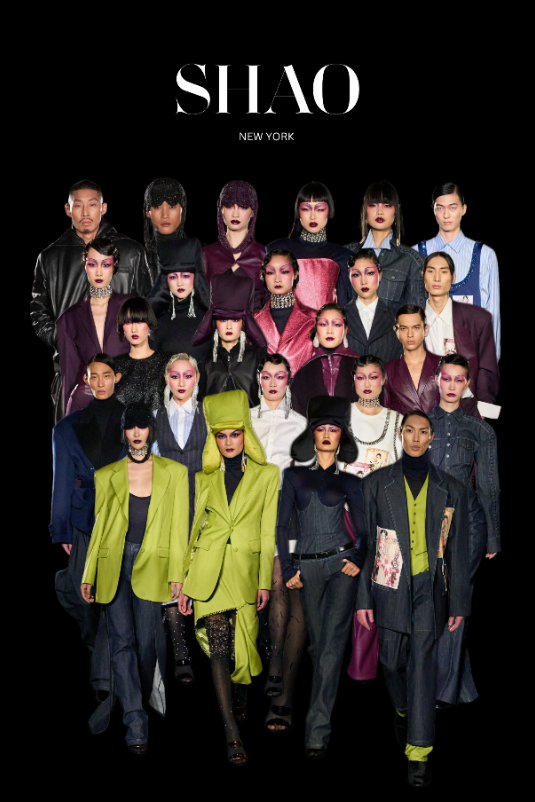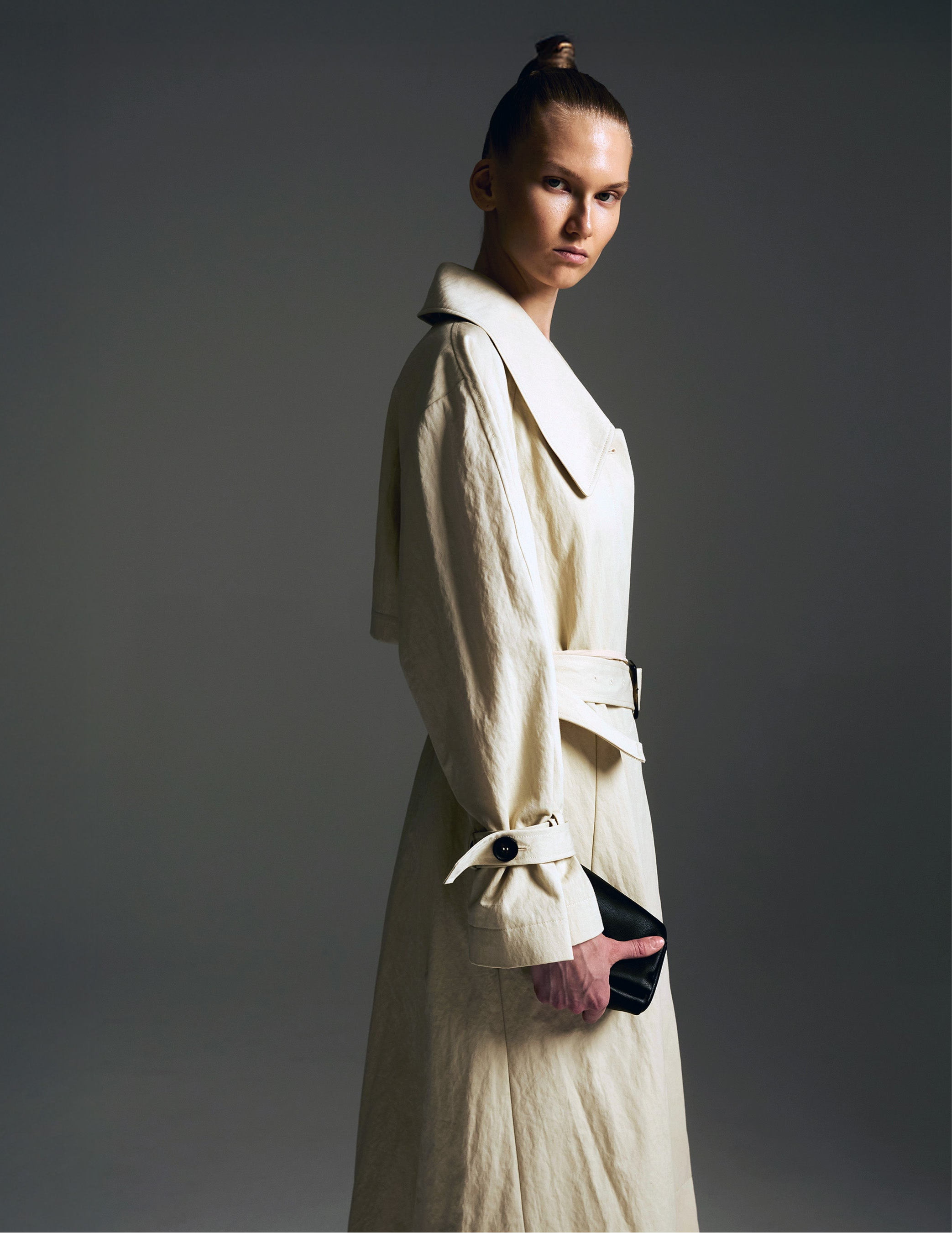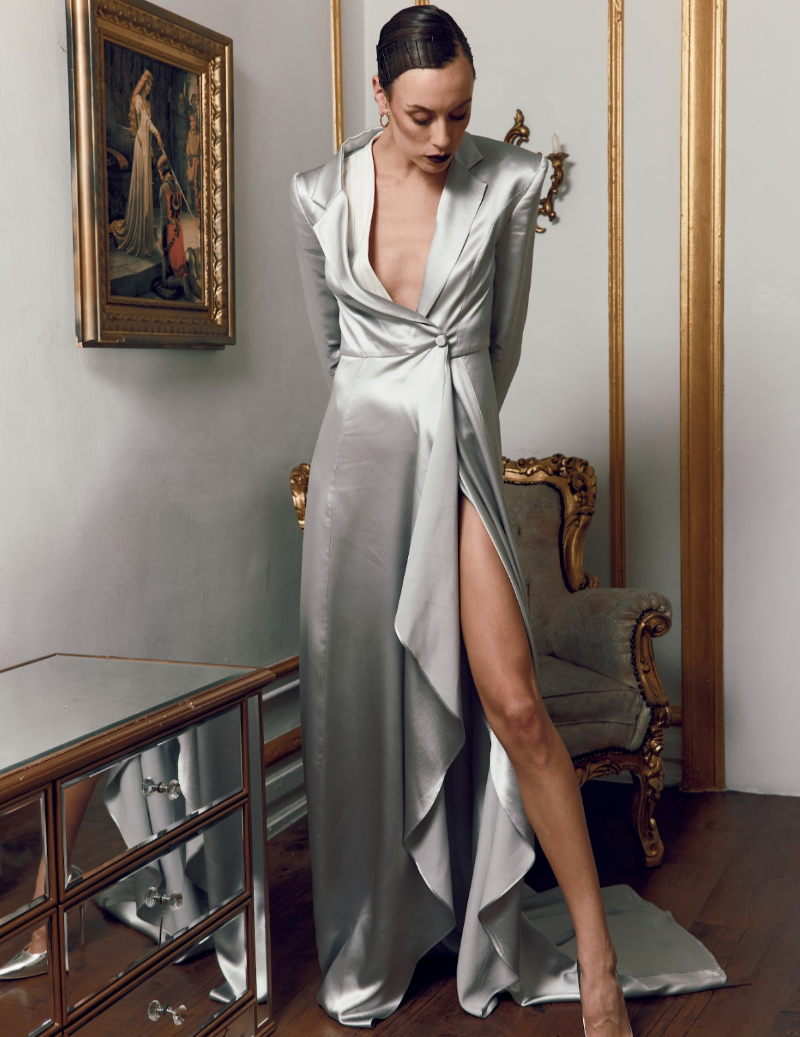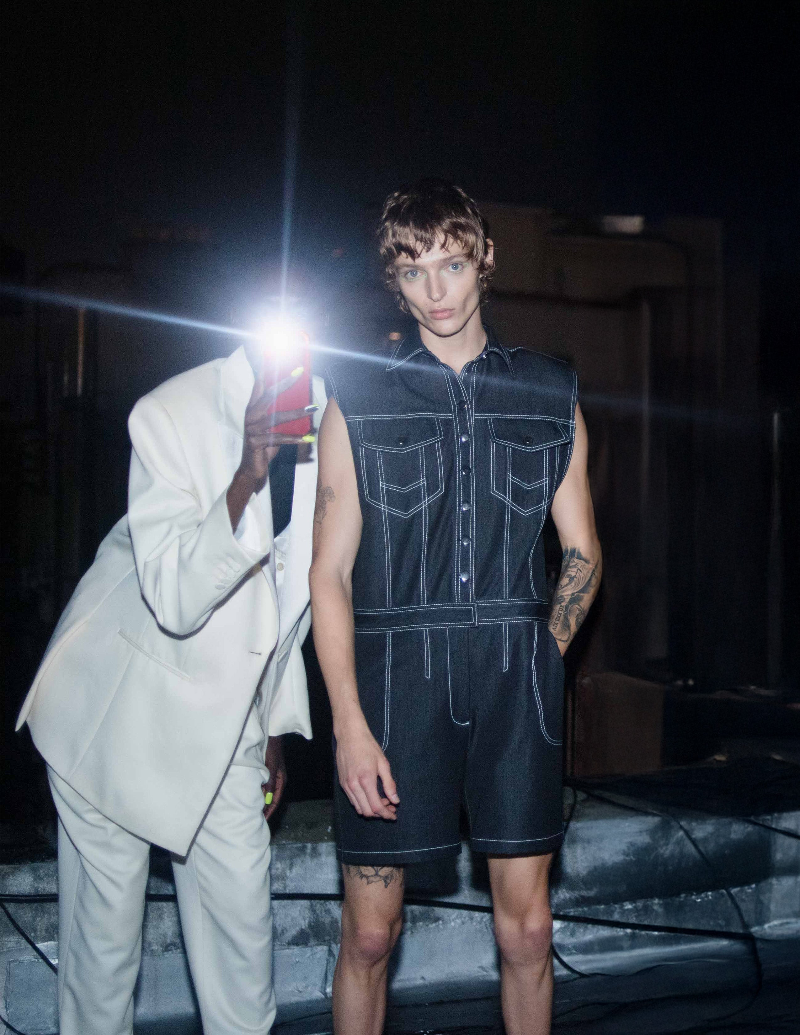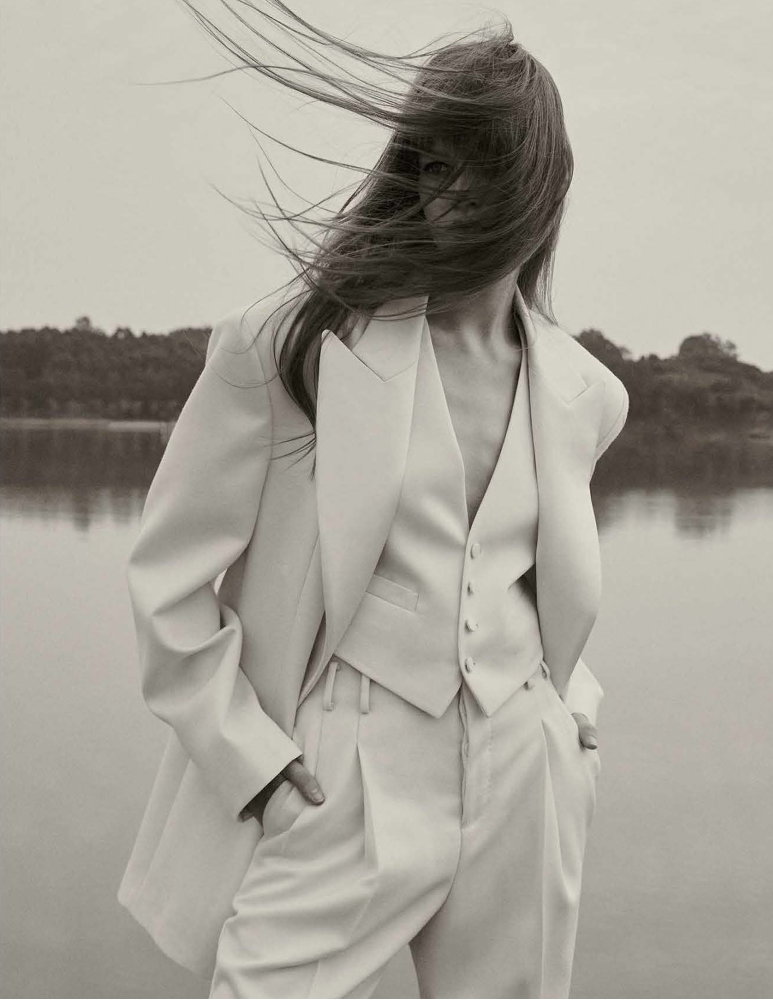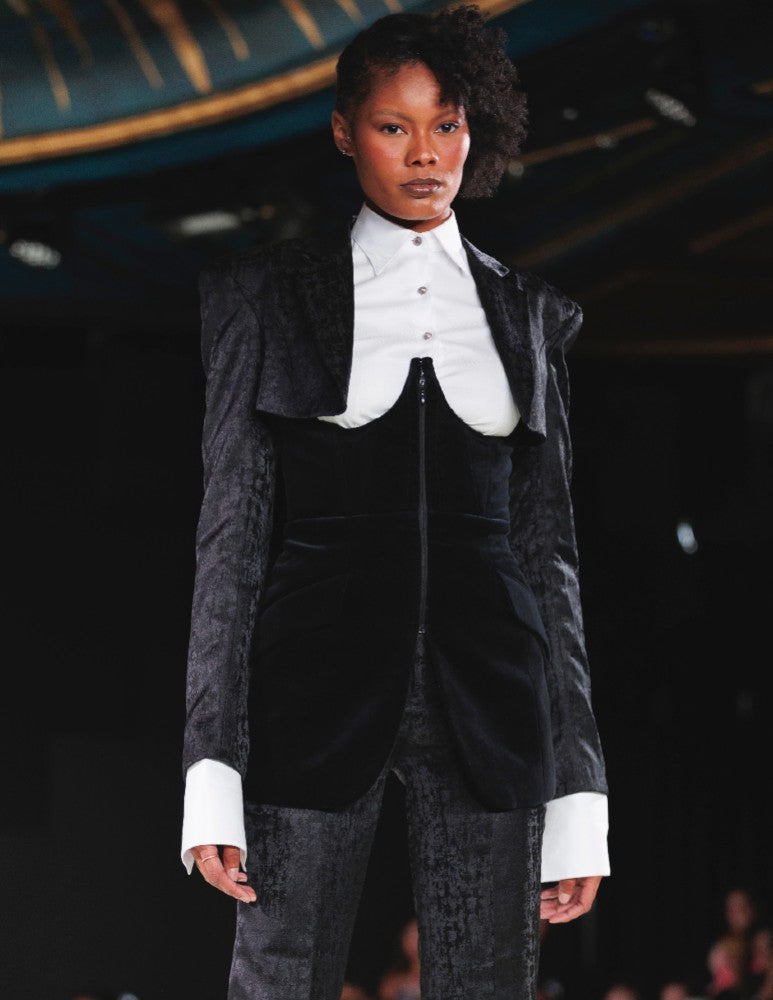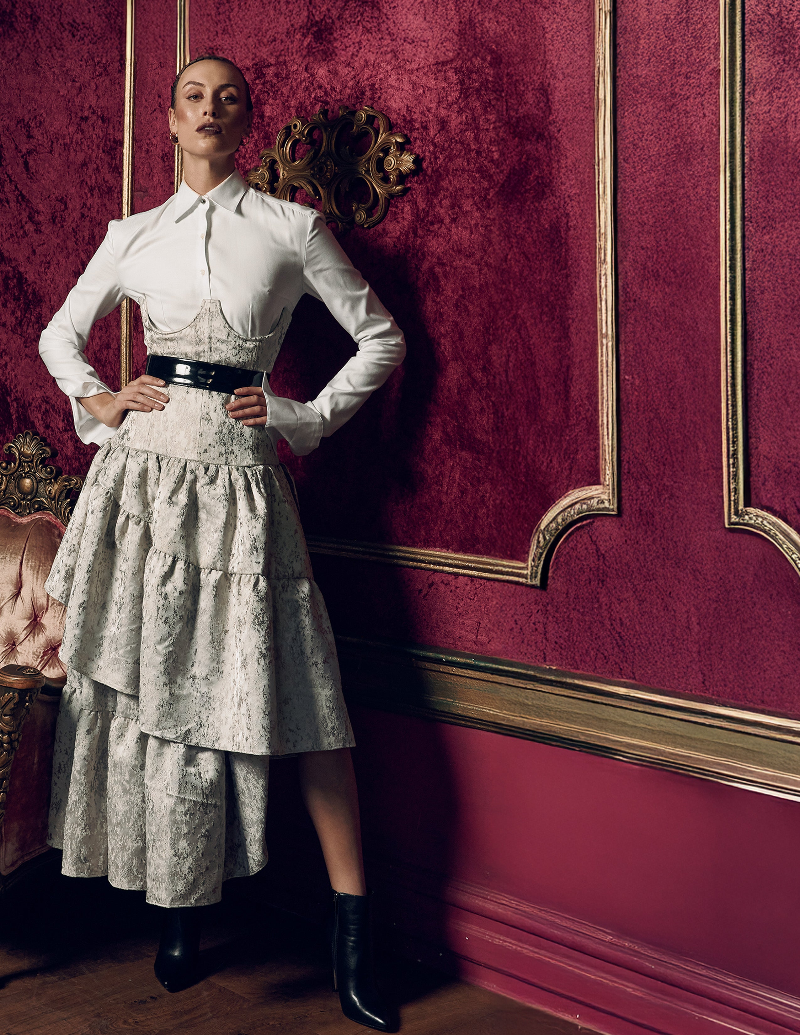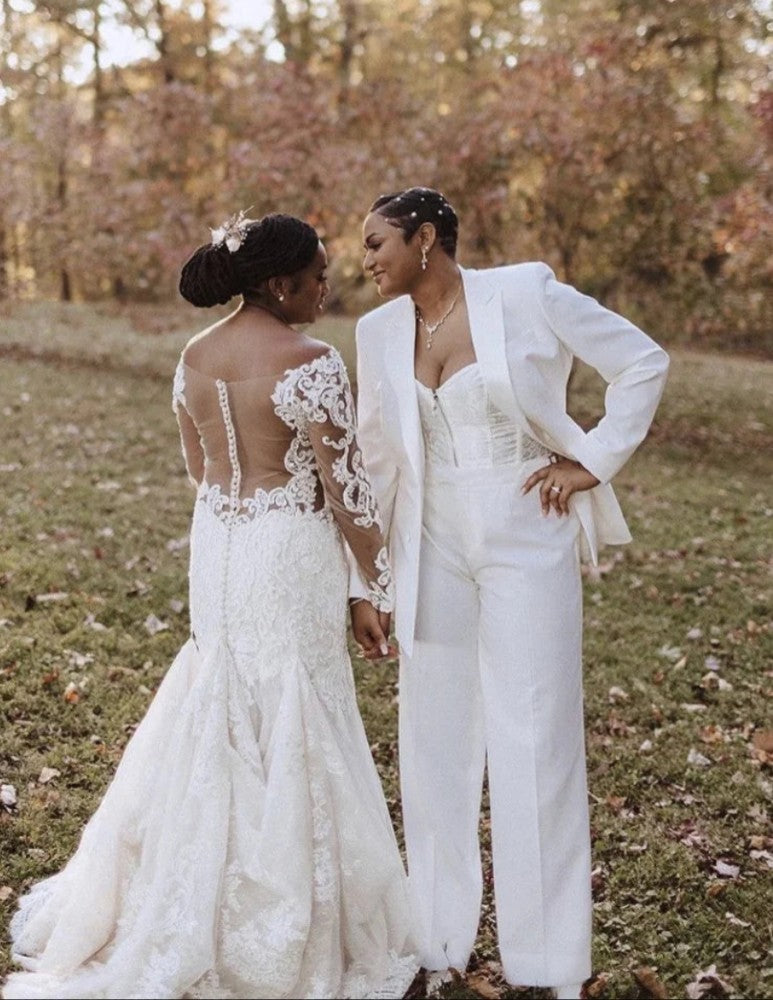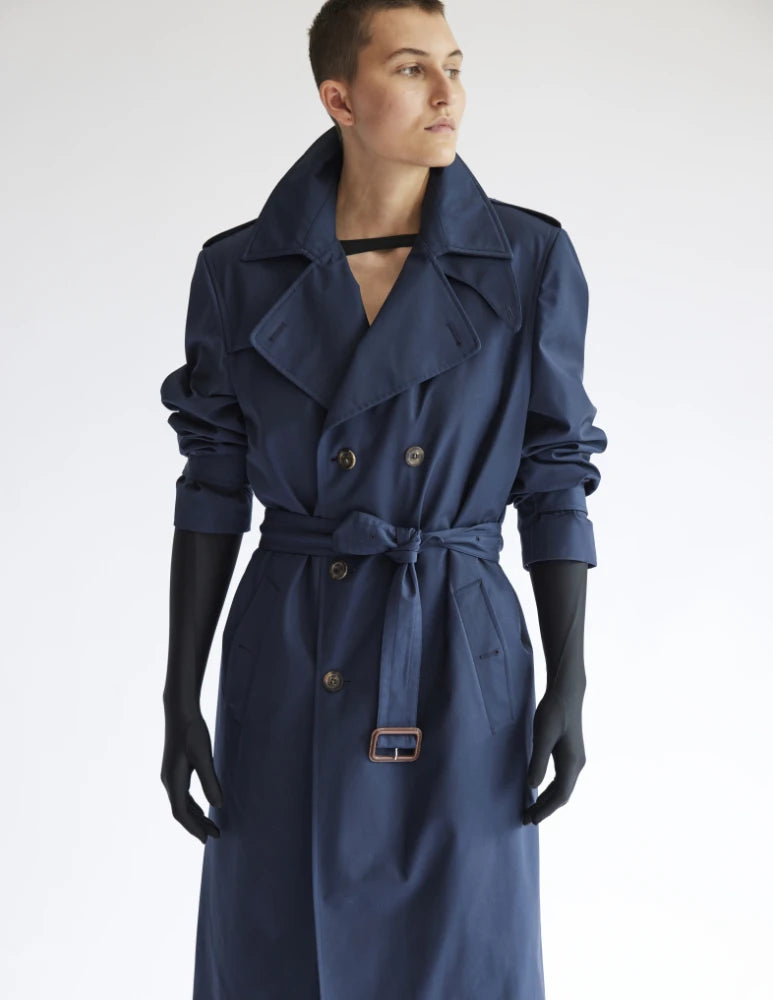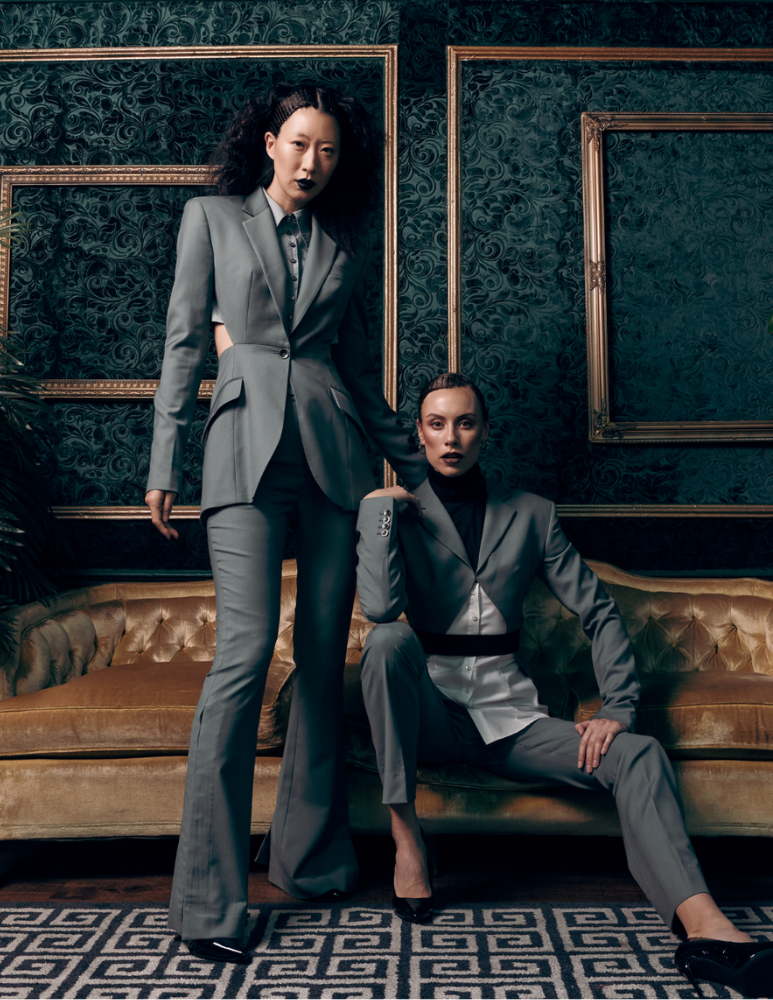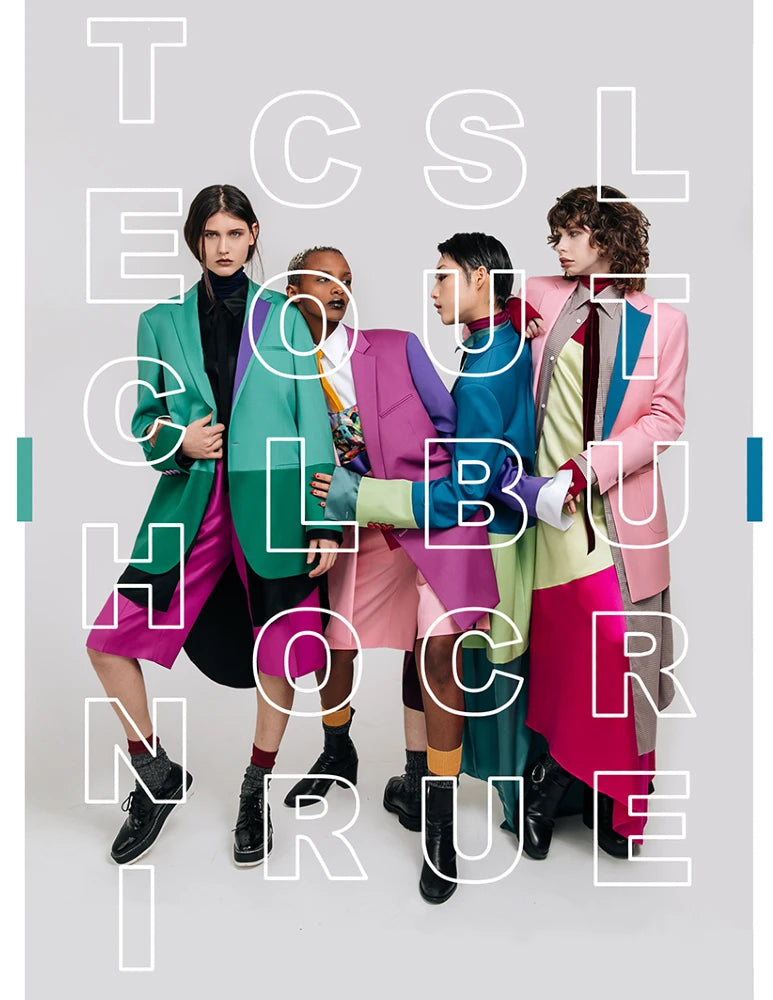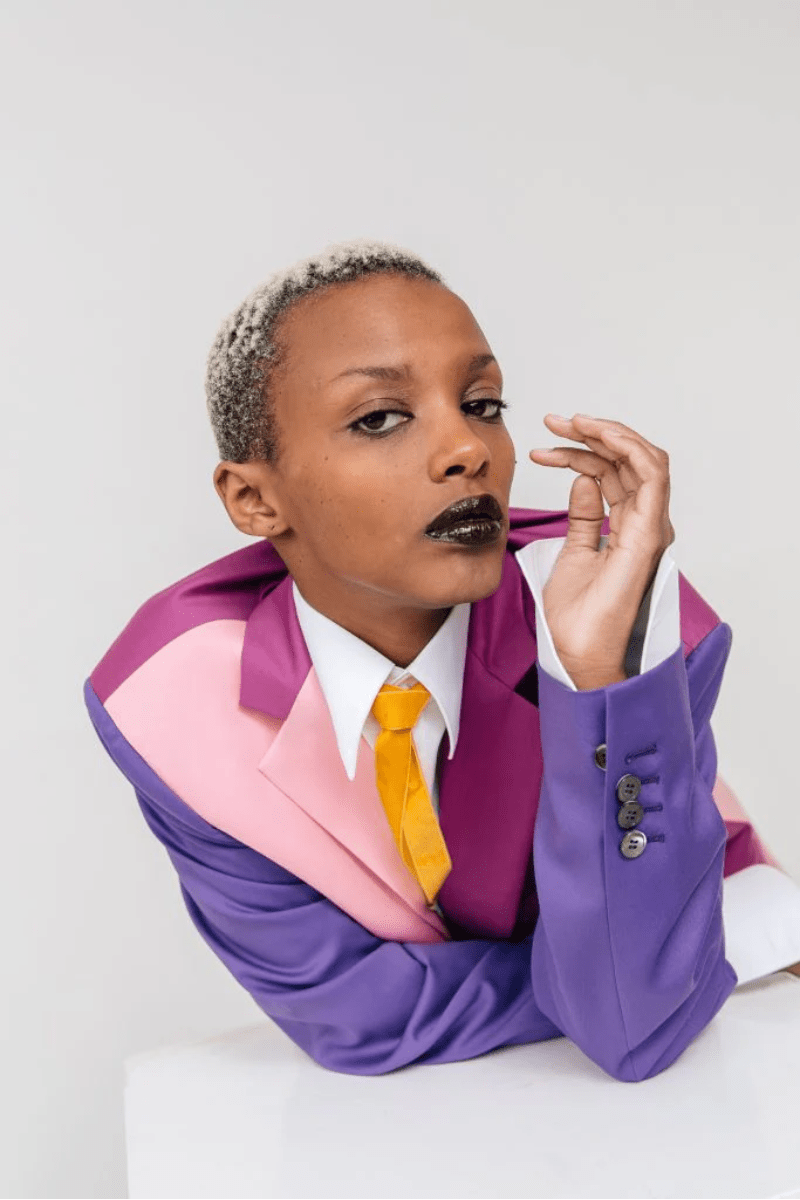Technical Foundations for Teal Construction
Teal's color properties create specific construction requirements that distinguish it from more conventional suiting colors. The undertones shift dramatically depending on fabric texture and weave structure, requiring careful selection of materials that support consistent color presentation. Smooth-finished fabrics like worsted wool emphasize teal's blue undertones, while textured weaves such as tweed or flannel highlight its green components. Master tailors understand these relationships and select construction techniques that enhance rather than conflict with teal's natural characteristics.
Hand-canvassed floating chest pieces become particularly important in teal suiting because the color's warmth requires structural support that maintains professional presence without appearing overly casual. The canvas construction provides necessary structure while allowing the fabric to drape naturally, preventing the color from overwhelming the wearer's frame. Princess seams and armscye adjustments require special attention in teal garments because the color's visual weight can affect perceived proportions differently than neutral alternatives.
Pressing techniques demand modification when working with teal fabrics because the color's sensitivity to heat and moisture affects both appearance and longevity. Traditional pressing methods might create shine or color variation that compromises the garment's professional presentation. Skilled artisans develop specialized approaches that maintain teal's depth while achieving the crisp lines essential for formal suiting. These technical considerations justify the investment in expert construction for teal garments.
Thread selection becomes crucial for teal suiting because standard matching techniques often fail to account for the color's complexity. Buttonhole threads must complement both blue and green undertones while maintaining visibility against the fabric. Hand-sewn details require thread choices that enhance rather than compete with teal's natural richness. The precision required for these technical elements separates quality teal suiting from amateur attempts.
Contemporary teal suiting increasingly incorporates performance elements that address practical wearing considerations. Moisture-wicking linings prevent color transfer during active wear. Stain-resistant treatments protect against the environmental factors that might compromise teal's appearance. These functional enhancements ensure that teal suiting maintains its visual impact through extended use rather than requiring careful preservation.
Seasonal Adaptability Across Climate Zones
Teal's warmth makes it particularly suitable for transitional seasons when traditional navy feels too heavy and lighter colors appear premature. Spring teal suiting embraces the color's green undertones, complementing renewal themes while maintaining professional appropriateness. The color's natural affinity for both cool and warm environments allows for versatile seasonal styling that extends wearing opportunities throughout the year.
Summer teal suiting requires fabric selection that maintains color integrity while providing breathability and comfort. Lighter-weight fabrics like tropical wool or linen blends preserve teal's sophistication while accommodating warm weather requirements. The color's inherent coolness provides psychological comfort even in higher temperatures, making it an excellent choice for summer professional wear or warm-climate business travel.
Fall applications of teal suiting capitalize on the color's compatibility with earth tones and richer seasonal palettes. Teal's complexity allows it to bridge summer's brightness with winter's depth, creating sophisticated looks that transition seamlessly between seasons. The color's warmth becomes particularly appealing as temperatures drop, providing visual comfort that complements physical warmth from quality construction.
Winter teal suiting explores the color's darker possibilities through fabric selection and styling approaches. Deeper teal tones complement winter's reduced light levels while maintaining the color's essential character. Heavier fabrics like cashmere or wool blends provide warmth while supporting teal's natural richness. The color's ability to appear both sophisticated and approachable makes it ideal for winter networking events and holiday celebrations.
Geographic considerations influence teal suiting success across different regional preferences and lighting conditions. Urban environments often provide the sophisticated backdrop that enhances teal's metropolitan appeal. Coastal regions complement the color's aquatic associations while maintaining professional appropriateness. International business contexts benefit from teal's cultural neutrality and universal appeal.
Styling Strategies for Professional Contexts
Teal suiting requires strategic approach to accessory selection that honors the color's complexity while maintaining professional presentation standards. Traditional black accessories often create too stark a contrast with teal's warmth, while brown alternatives might appear too casual for formal contexts. Cognac leather goods provide sophisticated complementarity that enhances teal's richness without competing for attention.
Shirt selection becomes crucial for teal suiting success because the color's undertones affect how different whites and patterns appear. Crisp white shirts provide classic contrast that emphasizes teal's sophistication, while cream or ivory alternatives create warmer combinations that highlight the color's green components. Subtle patterns like micro-checks or fine stripes can add visual interest without overwhelming teal's natural complexity.
Tie selection for teal suiting offers opportunities for creative expression within professional boundaries. Navy ties provide safe complementarity that maintains conservative presentation, while burgundy or deep purple alternatives create sophisticated color relationships that demonstrate style confidence. Pattern mixing requires careful consideration of scale and color relationships to avoid visual confusion.
Footwear choices significantly impact teal suiting's overall success because the color's warmth affects how different shoe colors appear in combination. Traditional black shoes provide stark contrast that emphasizes formal presentation, while brown alternatives create warmer combinations that enhance teal's approachability. Oxblood or burgundy shoes offer sophisticated middle ground that complements teal's complexity.
Contemporary teal suiting increasingly incorporates pocket squares and lapel pins that enhance the color's visual impact while maintaining professional appropriateness. Complementary colors like coral or gold provide sophisticated contrast, while analogous choices like navy or forest green create harmonious relationships. The key lies in balancing creative expression with professional requirements.
Cultural Code-Switching Through Color Psychology
Teal's psychological associations vary significantly across different cultural contexts, requiring sophisticated understanding of color symbolism and appropriate application. In Western business cultures, teal suggests creativity balanced with reliability, making it suitable for industries that value innovation within structured frameworks. The color's association with calm professionalism makes it particularly effective for client-facing roles or leadership positions.
International business contexts benefit from teal's cultural neutrality and positive associations across diverse populations. Unlike colors with strong cultural or religious significance, teal maintains universal appeal while suggesting sophistication and thoughtfulness. This versatility makes it ideal for global business travel or multicultural professional environments.
Generational differences in color perception affect teal's reception across age groups within professional settings. Younger professionals often appreciate teal's contemporary appeal and creative implications, while older colleagues might require more conservative styling approaches to accept the color's professional validity. Successful teal suiting navigates these generational expectations through thoughtful construction and styling choices.
Industry-specific color expectations influence teal suiting's appropriateness across different professional contexts. Creative industries typically embrace teal's innovative implications, while traditional sectors might require more subtle applications or conservative styling approaches. Understanding these industry dynamics ensures that teal suiting enhances rather than compromises professional effectiveness.
Regional preferences and climate associations affect teal's reception across different geographic markets. Coastal regions often embrace teal's aquatic associations and natural appeal, while inland areas might prefer more traditional color choices. Successful teal suiting considers these regional factors while maintaining individual style preferences.
Investment Economics and Wardrobe Integration
Teal suiting represents strategic investment in wardrobe differentiation that supports professional advancement and personal brand development. The color's memorability creates lasting impressions that distinguish wearers from conventional navy and gray alternatives. This differentiation often translates into enhanced professional recognition and networking effectiveness that justifies the investment in quality construction.
Versatility calculations for teal suiting reveal surprising adaptability across diverse wearing contexts. The color's sophistication makes it suitable for formal business settings, while its warmth allows for more casual professional applications. This range extends wearing opportunities and improves cost-per-wear ratios compared to single-context garments.
Quality construction becomes particularly important for teal suiting because the color's visual impact depends heavily on fabric quality and construction precision. Inferior materials or construction techniques can make teal appear cheap or costume-like, while superior craftsmanship elevates the color to sophisticated professional presentation. This quality relationship justifies investment in expert tailoring for teal garments.
Wardrobe integration strategies maximize teal suiting's versatility through strategic component selection and styling approaches. Separates allow for multiple combinations that extend wearing opportunities while maintaining consistent color presentation. Quality accessories enhance teal's visual impact while providing styling flexibility across different contexts.
Contemporary teal suiting increasingly addresses sustainability considerations through fabric selection and construction techniques that ensure longevity. Quality materials maintain color integrity through repeated wear and cleaning, while superior construction techniques allow for alterations and updates that extend garment life. These sustainability factors align with contemporary values while supporting investment justification.
Fabric Selection for Optimal Teal Presentation
Teal's color properties require careful fabric selection that supports consistent presentation while maintaining professional appearance standards. Natural fibers like wool and cotton provide excellent color retention and visual depth, while synthetic blends might appear flat or artificial. The fabric's texture significantly affects how teal appears under different lighting conditions, requiring strategic selection based on intended wearing contexts.
Weave structure influences teal's visual impact through light reflection and texture variation. Smooth worsted wools emphasize teal's blue undertones and formal sophistication, while textured weaves like tweed highlight green components and casual warmth. Understanding these relationships allows for strategic fabric selection that achieves desired presentation effects.
Weight considerations affect teal's seasonal appropriateness and professional application. Lighter-weight fabrics maintain color vibrancy while providing comfort in warm conditions, while heavier materials create richer color depth suitable for formal contexts or cooler climates. The fabric weight also influences drape and construction requirements for optimal fit and appearance.
Fiber content affects teal's maintenance requirements and long-term appearance preservation. Natural fibers typically provide superior color retention and aging characteristics, while synthetic components might offer practical benefits like wrinkle resistance or moisture management. Blended fabrics often combine advantages from multiple fiber types while maintaining teal's essential character.
Contemporary fabric technologies offer enhanced performance characteristics that support teal suiting's practical requirements. Moisture-wicking properties prevent color transfer and maintain comfort during active wear. Stain-resistant treatments protect against environmental factors that might compromise teal's appearance. These technological enhancements ensure that teal suiting maintains its visual impact through extended use.
Lighting Considerations for Teal Success
Teal's color complexity creates unique lighting challenges that affect professional presentation across different environments. Natural daylight typically provides the most accurate color representation, while artificial lighting can dramatically alter teal's appearance and undertones. Understanding these lighting relationships ensures appropriate teal suiting selection for specific contexts and environments.
Indoor lighting conditions significantly impact teal's professional presentation because different light sources emphasize different color components. Fluorescent lighting often enhances teal's blue undertones while diminishing green components, creating cooler overall appearance. Incandescent lighting has the opposite effect, warming teal's green undertones while reducing blue components.
LED lighting increasingly dominates professional environments, creating new considerations for teal suiting presentation. LED color temperature affects how teal appears, with cooler LED lighting enhancing blue undertones and warmer LED lighting emphasizing green components. Understanding these relationships allows for strategic teal suiting selection based on anticipated lighting conditions.
Photography considerations become important for teal suiting because the color's complexity affects how it appears in professional headshots and marketing materials. Camera sensors and editing software might interpret teal differently than human perception, requiring communication with photographers about color accuracy expectations and post-processing requirements.
Seasonal lighting variations affect teal's appearance throughout the year, requiring strategic styling approaches that maintain consistent presentation. Spring and summer's bright natural light showcases teal's vibrancy, while fall and winter's reduced illumination might require lighter teal tones or enhanced styling to maintain visual impact.
Future Evolution in Teal Suiting
Contemporary teal suiting continues evolving as color technology advances and cultural preferences shift toward more personalized professional presentation. Digital color matching systems enable more precise teal reproduction across different materials and production methods. These technological capabilities expand teal's accessibility while maintaining quality standards for professional application.
Sustainable fabric development affects teal suiting through eco-friendly dyeing processes and renewable fiber sources that maintain color integrity while reducing environmental impact. Natural dyes and organic fibers provide environmentally conscious alternatives that align with contemporary values while preserving teal's essential characteristics.
Cultural acceptance of alternative suiting colors continues expanding as professional environments become more diverse and inclusive. Teal's growing acceptance in conservative industries reflects broader shifts toward individual expression within professional contexts. This cultural evolution supports increased investment in teal suiting as a viable professional wardrobe choice.
Customization technologies enable more precise teal color matching and personalization that reflects individual preferences and requirements. Digital pattern-making and automated construction techniques allow for greater precision in teal suiting production while maintaining quality standards. These technological advances support increased accessibility and customization possibilities.
Global fashion influence continues expanding teal's cultural associations and styling possibilities as international business becomes more prevalent. Cross-cultural exchange introduces new approaches to teal styling and color combination that expand creative possibilities while maintaining professional appropriateness.
The future of teal suiting lies in its continued evolution as both a sophisticated color choice and a symbol of professional confidence. Clients who embrace teal understand that true style leadership requires thoughtful risk-taking balanced with technical precision. Teal suiting provides the perfect vehicle for this balance—a color that suggests creativity and warmth while maintaining the authority essential for professional success.
Quality construction remains the foundation for successful teal suiting, regardless of evolving trends or technological advances. The color's complexity demands technical expertise and cultural intelligence that separate investment pieces from casual attempts. Teal suiting succeeds when it reflects both color mastery and construction excellence—creating garments that serve as vehicles for professional advancement and personal expression.
Contemporary professionals increasingly recognize teal as a strategic choice that supports career development through memorable presentation and sophisticated differentiation. The color's warmth and complexity offer advantages that conventional alternatives cannot match, making teal suiting a valuable investment for those seeking to elevate their professional presence through thoughtful color selection and expert construction.

